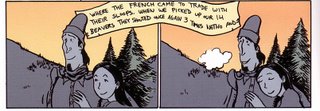Journey Into Mohawk Country
 Out of the entire First Second Fall 2006 line, this was the book that intrigued me most: simple illustrated history. It seemed like an interesting experiment, and at minimum a fascinating look at Colonial America. After getting the chance to read and digest it, I'm a bit confounded by Journey Into Mohawk Country. Much like Fate Of The Artist (also published by First Second), this has a hard time fitting within the confines of the "graphic novel" primarily because it's not a novel. But unlike Fate Of The Artist, this experiment in boundary stretching doesn't work as well.
Out of the entire First Second Fall 2006 line, this was the book that intrigued me most: simple illustrated history. It seemed like an interesting experiment, and at minimum a fascinating look at Colonial America. After getting the chance to read and digest it, I'm a bit confounded by Journey Into Mohawk Country. Much like Fate Of The Artist (also published by First Second), this has a hard time fitting within the confines of the "graphic novel" primarily because it's not a novel. But unlike Fate Of The Artist, this experiment in boundary stretching doesn't work as well.
It's not the concept that fails. George O'Connor used the unaltered 1634 diary of Harmen Meyndertsz van den Bogaert, a Dutch trader who travels amongst the Native American tribes populating the Northeast. It's a fascinating idea, that should allow for the grounding of dry history in a fresh vision, allowing us to bridge time and see the humanity that drove the early settlers. That humanity appears in fits and spurts, most notably in the backgrounds as one of van den Bogaert's associates falls in love with a Native American. It's subtle and clean, and shows the best of what a book like this can offer. O'Connor's characters are so expressive, that emotion flies off the page and really brings these historical footnotes to life.
The problem is that "there's no there there". While it's an interesting experiment, Journey Into Mohawk Country doesn't have a story to tell. There's an itemized list of adventures and trading victories and facts, but it doesn't build into a tale worth reading. There's no spine, no journey beyond the literal passage of miles. It seems like O'Connor realizes this, and introduces an epiphany near the end - a dream sequence that tries to transform the diary into an epic journey of self-discovery. It it so sudden and abrupt that it fails at making van den Bogaert's story into something significant beyond it's historical place. It's an enjoyable book largely because of O'Connior's wonderful cartooning, but fails at the trick that all great history writers have of taking dry facts and making them as compelling as fiction.

No comments:
Post a Comment